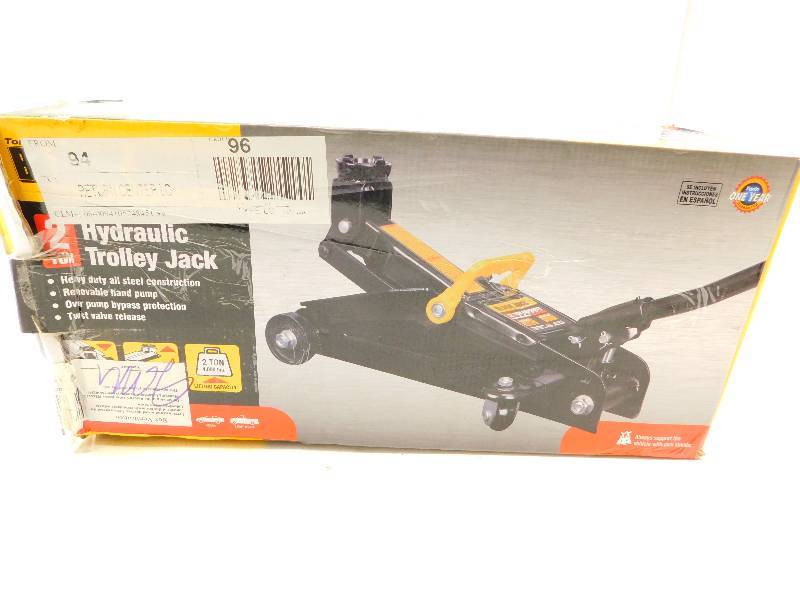How To Use Black Jack Hydraulic Trolley Jack
Pull the pin up to lock the jack in place. Begin to pump the handle in an up and down motion to raise the vehicle, making sure to always keep your head away from the handle in case of a slip. When lowering the vehicle, never attempt to grab the handle if it slips from your grasp. On vehicles without recovery points.
Written by Steven Douglas; Updated July 21, 2017Things You Will Need
Clean rags
Small plastic funnel
Screwdriver (depending on make/model)
Socket set (depending on make/model)
Hydraulic jack fluid (per manufacturer's specifications)
Cookie sheet with 1-inch rim
Tip

Do not overtighten the fluid release valve counter as damage to the jack may result.
How A Hydraulic Jack Works
When it comes to lifting a heavy object at home such as a car, camper, trailer or lawn tractor, many homeowners turn to a hydraulic floor jack to do this work. There are many makes and models available, but all operate on the same basic principal--fluid is alternately pumped between two chambers, forcing a piston to rise according to its fluid volume. If the hydraulic jack is not filled to its operational fluid capacity, then it will not be able to fully extend or lift to its advertised rating. The solution to this situation is to correctly maintain the hydraulic fluid level in your jack at all times. This is not a hard proposition, you just need to know where and when to add the suggested fluid type for your particular hydraulic floor jack.
Move the jack to a flat level surface so that you can safely inspect it. Look for abnormal component wear, such as cracked metal surfaces, broken welds, worn out casters (wheels) and hydraulic fluid leaks. Do not use the jack until these conditions are fixed.
Begin the hydraulic oil replacement by lowering the jack to its 'down' position. On most models this is accomplished by slowly turning the fluid release valve counterclockwise one-half turn to open it. The valve will be located on the end of the jack (away from the lifting end) at the base of the jack. The release valve is usually designed so that it can be turned with the jack handle.
Apply downward pressure to the jack with your foot or other heavy object until the jack is completely down. Turn the fluid release valve clockwise one-half turn to close it, or until it is snug.
Locate the oil filler screw. This is the port where oil is added when the fluid level is low, and is usually located near the fluid release valve on the opposite side of the jack. Wipe down the area surrounding the oil filler screw with a clean rag, so that no dirt or debris inadvertently fall into the port during the oil change procedure.
Remove the oil filler screw, using a screwdriver or socket wrench as applicable and set the screw aside. Turn the fluid release valve counterclockwise one-half turn to open it. Place a cookie sheet next to the jack near the oil filler hole (where the screw came from).
Turn the jack onto its side to drain the fluid out of the unit onto the cookie sheet. Be care not to spill any fluid on the floor since it will make the floor extremely slick. Turn the jack upside down to drain any remaining fluid.
Set the jack right side up (on its casters). Close the fluid release valve by turning it clockwise one-half turn or until it is snug. Add oil to the oil filler hole using a small funnel. Only add the suggested amount of fluid per the manufacturer's specification. If no specs are available, fill until the oil level is within 1/8 inch of the top of the oil filler hole.
Remove any trapped air from the hydraulic system components by opening the release valve one-half turn, then briskly pump the handle of the jack a few times (to simulate 'raising' the jack). Be sure to use the full range of motion with the jack handle. Check that the fluid level is still within 1/8 inch of the top of the oil filler hole. Add oil if necessary, then replace the oil filler screw. The jack is now ready to use.

References (2)
About the Author
Residing near the Central Florida beaches, Steven Douglas has written extensively on resolving small-business issues since 1990 in publications such as ForexFactory, Forex-Tsd, FxStreet and FxFisherman. After earning a master's degree in administration from the University of Maryland, his primary focus has been on international currency trade and how it can be effectively utilized by small businesses across the United States.
Cite this Article